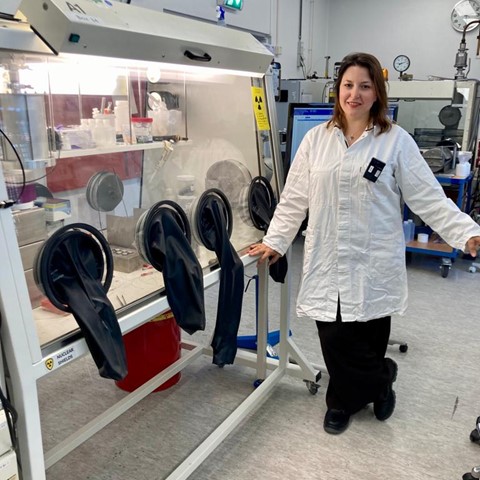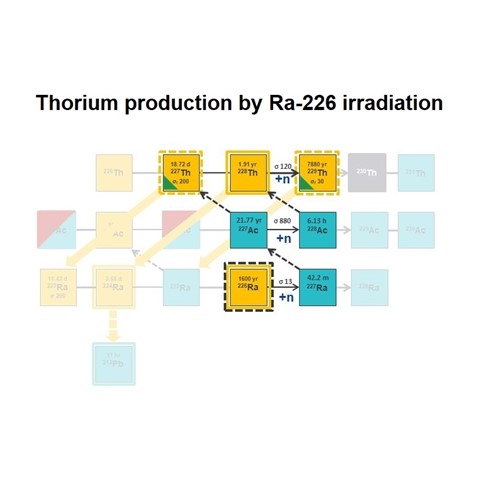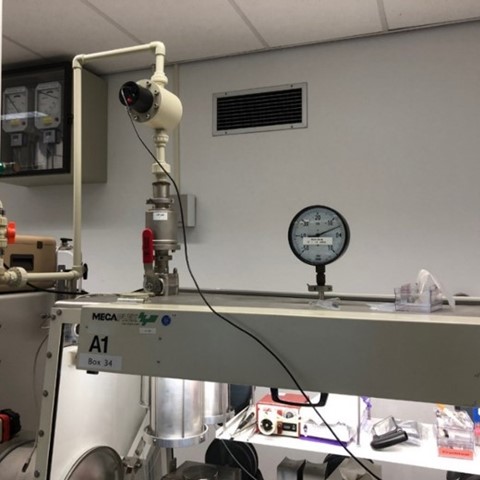Practical aspects in the production of alpha-emitters
Practical aspects in the production of alpha-emitters
08 August 2022
The interest in alpha emitters is rising as the field of targeted alpha therapy (TAT) is advancing towards clinical studies. The major bottleneck for research and development of radiopharmaceuticals for TAT is its limited availability. Limited amounts are obtained from historical uranium or actinium sources or by thorium decay. The irradiation of Radium-226 could be a game changer as the amounts produced using this method could fulfill the market needs for alpha-emitters. However, there are several challenges in 226Ra target preparation and further processing of irradiated targets.
Subscribe to our newsletter!

Demand alpha emitters exceeds supply
Yulia Buchatskaya, NRG’s Lead Scientist Medical Isotopes Development, recently gave a presentation at the 30th NKRV Workshop about the challenges and practical difficulties foreseen in the production and processing of alpha emitting isotopes using nuclear reactors. “Alpha emitters are of high interest in the current nuclear medicine field due to their expected successful applications within targeted radionuclide therapy. The demand for alpha emitters currently exceeds its supply and availability”, explains Yulia.
Currently in the world, there are several places where you can still produce alpha emitters, but they are mostly produced from historical uranium, actinium or thorium sources. And its availability is limited. Most of the alpha emitters can be produced from thorium sources: 223Ra is produced from 227Th, 224Ra and 212Pb are produced from 228Th and 225Ac and 213Bi are produced from 229Th.
Irradiation of Radium-226
As thorium can be produced by irradiating 226Ra, could this method be the future for the production of alpha-emitters? By irradiating 226Ra with neutrons, 227Ra is produced that simultaneously decays to 227Ac and 227Th. In its turn, irradiation of 227Ac and 227Th produces other isotopes of Thorium: 228Th and 229Th.
Using Radium-226 as the source material for these thorium isotopes could be the solution for the shortage of alpha emitters in the market. However, there are several challenges in 226Ra target preparation and processing. Special equipment is required to detect α-particles, like scintillators and semiconductors. Also, a fume hood or glove box is necessary to prevent the radioactive fumes from spreading. Monitoring and specially designed gas-trapping filters or leak-tight equipment are required due to presence of gaseous radioactive isotope Radon-222is necessary.

“We can recycle this old nuclear waste to produce further radiopharmaceuticals using the nuclear reactor”
Handling of alpha-emitters
The handling of alpha-emitters is done in special laboratories. These radionuclide laboratories are divided in different categories based on the amount of radiotoxicity and amount of activity allowed. For the handling of small amounts of alpha-emitters a B-lab is required, whereas 2000 Reinh is only allowed to be used in the glove box. But just the right lab is not enough. You need a special license from the Dutch authorities to do research and production. Also, an additional risk analysis needs to be done, extra documentation is required and you need specially trained staff.
Recycling nuclear waste
Based on their decay chain, there are three mains groups of alpha emitters, Actinium-225, Lead-212 and Radium-223. In theory, all three isotopes can be produced in our nuclear reactor from Radium-226 sources. And Radium-226 is actually a nuclear waste. It can be obtained as a byproduct of uranium mining. 226Ra was also used in needles for brachytherapy, a popular treatment for cancer in the 20th century. “We can recycle this old nuclear waste to produce further radiopharmaceuticals using the nuclear reactor. That is a nice idea!”, says Yulia.

Upscaling for small-scale GMP production
Within FIELD-LAB the necessary R&D facilities have been set-up, tested and are being used to solve the challenges of handling alpha emitters and deal with them for R&D purposes. FIELD-LAB is a drug discovery consortium that will help partners speed up the development and market launch of new nuclear drugs for cancer treatment. NRG is developing processes to produce new isotopes such as Lead-212 and partners are developing new radiopharmaceuticals. NRG is also constructing FIELD-LAB GMP facilities.
According to Yulia, they are now producing targets to develop the up-scaled process needed for FIELD-LAB productions of Pb-212 to be used for phase I and phase II clinical studies. “So far, we only irradiate small amounts for R&D purposes, but in the FIELD-LAB facilities we can upscale for small-scale GMP production. And we can provide this knowledge to the radiopharmaceutical world.”
More information?
Do you wish to learn more on lead-212 and how FIELD-LAB can help you? Get in touch with us!

